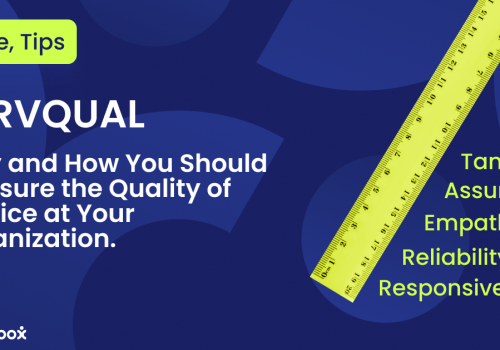Support Team. Prospecting is often considered the very first step in the sales process, where the rep will identify potential customers (prospects). While this is usually done by the sales team, it doesn’t have to be. In 2021, businesses are moving away from the rigid structure of every team having a completely separate role. Today, it’s more about breaking down silos so every team can play a role in supporting the broader vision of the company. Today we’re going to discuss six ways your support team can help in prospecting.
1. Upsell and Cross-Sell
Upselling and cross-selling might sound intuitive, but so many companies get it wrong. When it comes to support teams, the key to upselling and cross-selling is to do it when it’s appropriate. Not every interaction will be a good fit for this strategy. For example, suppose a customer is speaking to someone on the customer service team about a frustrating account log-in issue. In that case, it’s unlikely to be an excellent time to sell more services to the customer. After all, they’re already having trouble accessing your basic services; why would they want to buy more and potentially open themselves up to more frustration?
Support teams must always be mindful of what their primary goal is. For customer support, their goal is to solve customer issues and have customers leave in a more positive attitude than when they arrived. For tech support, the goal is to make sure the product is working as intended so the customer can achieve their wants and goals through the item.
However, just because a support team member has a primary goal doesn’t mean they can’t be open to new goals, where appropriate. Certain conditions have to be met for the interaction to be appropriate:
- The customer has to be happy with the support agent. If you are having a negative interaction, upselling and cross-selling not only won’t work, but it may even spark anger.
- The customer has to have an unmet need. There’s no use upselling or cross-selling if the customer won’t benefit from the new features or product. And the benefit can’t be “it’s like what you have but even better”. The customer must express a want or a need for something that they aren’t getting with their current product.
If the customer has an unmet need and is generally positive in the interaction, then the support agent is still focusing on their primary goal (meeting the customer’s needs).
2. Support Teams and Product Improvement
Most companies have an FAQ section where customers and potential customers can go to find the answer to common problems. While FAQ sections do play an important role, it’s essential to not use them as a band-aid. What do we mean? If hundreds of customers are encountering the same problem, the issue is likely to do with the product rather than how clearly you’ve communicated the answer in your FAQs. Sometimes, it’s better to fix a problem, so customers no longer encounter it rather than coming up with new workarounds.
Support teams are in a unique position in that they have the best insight into these common problems and grievances. If you want to improve your products through your support teams, there are two things you should do:
- Look at the numbers: If you use a tagging system for your support tickets, you should get a clear indication of what problems are the most frequent.
- Speak to the support teams: Some customer problems don’t fit neatly into a tag. It could be a quirk of the software that different customers approach differently, but a wide range of customers still run into issues with it.
Once you’ve identified common customer pain points, it’s time to eliminate them. Not only does this provide a better experience for existing customers, but it makes your product more appealing to prospects. If potential customers can see that you continually improve your product based on customer feedback, they are more likely to trust you with their money.

3. Improve Communication Between Teams
It’s 2021, and it’s time to break down those silos between teams. In a thriving modern business, sales, customer support, and marketing teams should be able to share ideas and work towards common goals. There should be no “us vs them” mentality.
One key area that support teams can help is in defining the customer personas or ideal customer profile. Sales teams need to have a clear idea of the range of customers who buy the company’s products, as well as what motivates these customers. When you understand key attributes of your prospects like:
- Their demographic (age/gender etc)
- Marital status.
- Education and employment.
- Geographic location.
You can better understand how to approach them. Customer service teams are invaluable here because they talk to customers from every segment. They also talk to customers in situations where they are less guarded. For example, if a potential customer is talking to someone on the sales team, they are likely to have their guard up at least somewhat. Most people feel a little on edge talking to salespeople because we know we have something the salesperson wants (money). While this means that you, as the customer, hold ultimate power, most people are wary of being manipulated into buying something that isn’t a good fit for them. That’s not to say most sales reps operate like this. Most don’t – especially in 2021. Today the focus is much more on selling to people who actually want and need your products. However, most people can remember a bad experience they’ve had with a pushy salesperson well enough to put their guard up.
With customer service, power is much less one-sided. The customer has a problem that needs to be solved. They hold some power because they can demand a refund, a new product, or threaten to cancel their subscription if they don’t get a satisfactory outcome. However, the customer service agent also holds power because they hold the keys to solving the problem. This dynamic can create a much more relaxed atmosphere, as long as the customer isn’t too angry about the situation. The upside of this more equal exchange is that the customer service team can ask more questions and get a deeper understanding of the customer. The customer will likely feel more comfortable answering these questions from a customer service agent than from a sales rep. Not always, but most of the time.
The sales team and customer service team should communicate to decide things like:
- How much customer information should the agent ask for?
- What’s the process for passing on prospects to the sales team?
- Are there any marketing or sales content that is missing the mark with customers?
Ideally, the teams should be able to communicate via internal messaging systems and have a weekly meeting to discuss their respective roles and what they can do to support each other.
4. Referrals
Sometimes a customer will know someone else for who your product or service will be perfect for. In this scenario, the customer service agent can pass this information onto the sales team for prospecting. The key here is to be deliberate and careful.
It’s not a good idea for the customer service agent to bull-doze the conversation to ask the customer whether they have any friends that will also like the product. This can come across as overly pushy and inconsiderate. After all, the customer is calling to deal with their own problem (they are the main character here).
This type of contact gathering can only be done in very specific circumstances:
- The customer has to express a strong like for the product and the problems it has solved for them.
- They have to detail a specific instance there the product solved their problem or met a want.
From here, you can encourage the customer to suggest or imply that more people will benefit from the product. You can then ask questions about their circumstances like whether they use the product at work, whether they think it would help for X workplace activity, and so on.

5. Making Transitions Easy
One of the sure-fire ways to get more customers is to reduce customer effort. Many different factors go into reducing customer effort. For example, having a well-designed website that is easy to navigate so that customers can find what they want quickly. Allowing multiple contact channels also reduces customer effort because they can engage with you on their own terms.
Another way you can reduce customer effort is to make customer experiences seamless. For example, let’s say someone contacts your business through live chat. Maybe they are connected with a customer service agent, but they’re not a customer yet. They are simply interested in your product and want to find more information. In other words, they accidentally arrived in the wrong place, and they need to talk to a sales rep. The process of handing the customer from the customer service team to the sales team should be seamless and without friction.
If the potential customer is hit with friction at this easy stage, it can kill a sale before the sales team even begins to prospect them. Additionally, if the customer service agent is handing the prospect over to a different team, they should provide a quick brief of the interaction, so the potential customer doesn’t have to repeat themselves.
6. Encourage Reciprocity in Support Teams
Reciprocity is an observed psychological phenomenon where when someone does something nice for us, we are more likely to do something nice for them back. For example, one study found that when waiters delivered candy to diners when they gave them their check, tips went up.
Reciprocity is also an important concept in negotiations and business as a whole. For example, in the book Never Split The Difference, negotiation expert Chris Voss talks of how reciprocity can work against you in a hostage negotiation. For example, police used to ask the kidnapper, “can you send me X to prove the hostage is still alive?”. The problem with this method is that is triggers reciprocity. By following your instructions, the kidnapper has done something for you, which means they expect something back. It’s the unwritten rules of the game. However, you can get around this by asking an open question like “how do we know the hostage is alive?”. This forces the kidnapper to come up with an answer themselves and offer it to you. It was their idea, so it doesn’t trigger reciprocity as strongly as when we ask for something directly.
Now, of course, you’re not going to be taking your prospects hostage, but it’s worth remembering the power of reciprocity. Support teams that interact with prospects can offer free e-books or guides that can trigger reciprocity and make the prospect more likely to interact positively with the sales team.




















